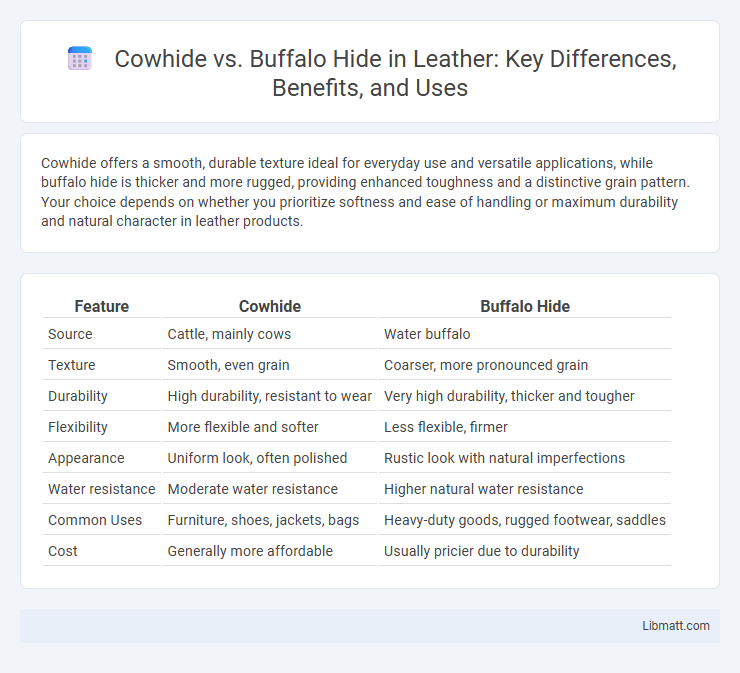Cowhide offers a smooth, durable texture ideal for everyday use and versatile applications, while buffalo hide is thicker and more rugged, providing enhanced toughness and a distinctive grain pattern. Your choice depends on whether you prioritize softness and ease of handling or maximum durability and natural character in leather products.
Table of Comparison
| Feature | Cowhide | Buffalo Hide |
|---|---|---|
| Source | Cattle, mainly cows | Water buffalo |
| Texture | Smooth, even grain | Coarser, more pronounced grain |
| Durability | High durability, resistant to wear | Very high durability, thicker and tougher |
| Flexibility | More flexible and softer | Less flexible, firmer |
| Appearance | Uniform look, often polished | Rustic look with natural imperfections |
| Water resistance | Moderate water resistance | Higher natural water resistance |
| Common Uses | Furniture, shoes, jackets, bags | Heavy-duty goods, rugged footwear, saddles |
| Cost | Generally more affordable | Usually pricier due to durability |
Introduction to Animal Hides
Cowhide and buffalo hide are two popular types of animal hides widely used in leather goods and upholstery industries. Cowhide is recognized for its smooth texture, durability, and versatility, making it suitable for fashion accessories and furniture. Buffalo hide is known for its rugged grain, thickness, and natural resistance to wear, often preferred for heavy-duty applications and rustic styles.
Understanding Cowhide: Features and Uses
Cowhide offers a durable, flexible leather known for its natural grain and resistance to wear, making it ideal for furniture upholstery, clothing, and accessories. Its moderate thickness and smooth texture provide comfort and longevity in products like jackets and handbags. The versatility and affordability of cowhide contribute to its widespread use across various leather goods industries.
Exploring Buffalo Hide: Characteristics and Applications
Buffalo hide is thicker and more durable than cowhide, offering superior resistance to wear and tear, making it ideal for heavy-duty applications like furniture and rugged footwear. Its natural grain is coarser with a distinctive texture that enhances both strength and aesthetic appeal, often preferred for high-end leather goods requiring longevity. When choosing between cowhide and buffalo hide, your decision should consider buffalo's robust resilience and unique character for products designed to endure harsh conditions.
Durability Comparison: Cowhide vs Buffalo Hide
Buffalo hide is generally more durable than cowhide due to its thicker grain structure and higher density, making it ideal for heavy-duty leather products. Cowhide, while still strong and resilient, is softer and more flexible but may show wear faster under extreme conditions. Both hides offer excellent longevity, but buffalo hide outperforms cowhide in abrasion resistance and ruggedness for long-term use.
Texture and Appearance Differences
Cowhide features a smoother texture with a tighter grain and more uniform appearance, often revealing subtle natural patterns and a soft, supple feel. Buffalo hide, in contrast, exhibits a coarser, more pronounced grain with rugged, deeply textured surfaces and natural scars, offering a distinctive, rustic aesthetic. The thicker, denser buffalo leather is known for its durability and bold, unique character compared to the finer, more polished look of cowhide.
Resistance to Wear and Tear
Buffalo hide demonstrates superior resistance to wear and tear compared to cowhide due to its denser fiber structure and thicker grain. This makes buffalo hide highly durable and ideal for products subjected to heavy usage, such as rugged boots and motorcycle gear. Cowhide offers good durability but generally shows signs of aging and abrasion faster than buffalo hide in high-stress applications.
Price and Market Availability
Cowhide typically commands a lower price compared to buffalo hide due to its widespread availability in global markets. Buffalo hide is rarer and often sourced from limited regions, leading to higher costs and less consistent market presence. The premium price for buffalo hide reflects its unique texture and durability, attracting niche buyers despite lower overall availability.
Common Uses in Leather Goods
Cowhide is frequently used in leather goods such as jackets, shoes, and upholstery due to its durability, flexibility, and affordability. Buffalo hide, known for its thicker, coarser texture and natural grain, is preferred in products like rugged boots, heavy-duty belts, and durable bags that require extra toughness. Your choice between cowhide and buffalo hide depends on the desired strength and texture for the specific leather item you need.
Sustainability and Ethical Considerations
Cowhide and buffalo hide both offer durable leather options, but buffalo hide tends to be more sustainable due to buffalo's lower environmental impact and efficient grazing habits. Ethical considerations favor buffalo hide as it often comes from animals raised in less intensive farming systems, promoting better animal welfare. When choosing your leather, opting for buffalo hide may support more responsible sourcing practices and reduced ecological footprints.
Choosing Between Cowhide and Buffalo Hide
Choosing between cowhide and buffalo hide depends primarily on durability and texture preferences, as cowhide offers a smooth, softer feel ideal for upholstery and clothing, while buffalo hide boasts a tougher, more rugged texture suited for heavy-duty applications like saddlery and work boots. Buffalo hide generally has a thicker grain and higher natural fat content, providing enhanced water resistance and long-lasting strength compared to cowhide. Cost considerations also play a role, with buffalo hide typically commanding a higher price due to its durability and scarcity relative to widely available cowhide.
Cowhide vs buffalo hide Infographic

 libmatt.com
libmatt.com